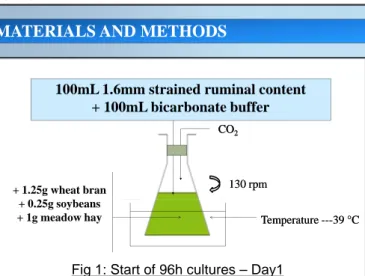To cite this document: Troegeler-Meynadier, Annabelle and Dusart, Clément and
Enjalbert, Francis and Farizon, Yves and Chemit, Marie-Luce Ruminal digestion:
development of medium-term cultures of ruminal content. (2014) In: 18th Congress of the
European Society of Veterinary and Comparative Nutrition, 11 September 2014 - 13
September 2014 (Utrecht, Netherlands).
O
pen
A
rchive
T
oulouse
A
rchive
O
uverte (
OATAO
)
OATAO is an open access repository that collects the work of Toulouse researchers and
makes it freely available over the web where possible.
This is an author-deposited version published in:
http://oatao.univ-toulouse.fr/
Eprints ID: 12258
Any correspondence concerning this service should be sent to the repository
administrator:
staff-oatao@inp-toulouse.fr
Ruminal digestion: development of medium
Ruminal digestion: development of medium--term cultures of ruminal
term cultures of ruminal
content
content
A.
A. Troegeler
Troegeler--Meynadier
Meynadier, C.
, C. Dusart
Dusart, F.
, F. Enjalbert
Enjalbert, Y.
, Y. Farizon
Farizon,
, M.L.
M.L. Chemit
Chemit,
,
UMR
UMR INRA
INRA // INPT
INPT ENSAT /
ENSAT / INPT
INPT ENVT GenPhySE ENVT F
ENVT GenPhySE ENVT F 31076 Toulouse FRANCE
31076 Toulouse FRANCE
UMR
UMR INRA
INRA /
/ INPT
INPT ENSAT /
ENSAT / INPT
INPT ENVT, GenPhySE, ENVT, F
ENVT, GenPhySE, ENVT, F--31076 Toulouse, FRANCE
31076 Toulouse, FRANCE
a.troegeler@envt.fr
a.troegeler@envt.fr
Batch cultures are commonly used to study ruminal digestion because they are easy to implement. Nevertheless, most are short term studies (a few hours)
h bl l ff f di h h
INTRODUCTION
Fig 3: Evolution of fermentation parameters during the 96h cultures.6 7 6,8 6,9 7 250 300 350 400 ON
that are unable to evaluate effects of dietary changes that affect the microbiota, which needs more than 24h to become apparent. So, this study aimed at evaluating persistency of microbial activities during medium-term (96h) cultures of ruminal contents.
MATERIALS AND METHODS
6,2 6,3 6,4 6,5 6,6 6,7 0 50 100 150 200 250 12 24 36 48 60 72 84 CONCENTRA TI (MMOL/L)
CULTURE DURATION (HOURS)
+ 1.25g wheat bran
100mL 1.6mm strained ruminal content + 100mL bicarbonate buffer
CO CO22
Compared to fresh ruminal contents, 96h cultures resulted in a twice lower NDF disappearance (16 vs. 28% in 96 h and fresh cultures, respectively), a similar nitrogen disappearance (14 vs. 13% in 96 h and fresh cultures, respectively) and a twice higher starch disappearance (91 vs. 43% in 96 h and fresh cultures, respectively). Moreover 96h cultures resulted in a 24% higher
130 130 rpmrpm
AGV totauxTotal VFA NH3 pH
Fig 1: Start of 96h cultures – Day1
•Every 12h, the same quantities of substrates were added to each flask with 100 ml bicarbonate buffer, after removing half of the 200mL media.
Temperature Temperature ---39 39 °°CC
+ 0.25g soybeans + 1g meadow hay
Table 1: Biohydrogenation activities of 96h ruminal cultures compared to that of fresh ruminal content used at J1 to start cultures.
biohydrogenation extent of linoleic acid with an increase by 61% of trans-11 isomers production (Table1).
J1 J5 SEM P
•VFA, NH3 and pH were recorded every 12h.
•Ruminal content at J1 and 96h cultures were used for measurement of microbial activities.
Mesurement of microbial activities (carbohydrate and nitrogen disappearance and FA biohydrogénation):
•Inoculum was 100mL of rumen content or of 96h culture added with 100mL of bicarbonate buffer
S b t t 2 5 f h t b + 0 5 f b c9c12-C18:2 Disappearance (%) 55.7 69.2 1.7 <0.01 t10 FA Initial quantity (mg) 0.4 0.8 - -Final quantity (mg) 1.8 2.8 0.3 0.04 Production (mg) 1.3 2.0 - -t11 FA Initial quantity (mg) 5.6 17.8 - -Final quantity (mg) 21.6 43.7 0.9 <0.01
•Substrates were: 2.5g of wheat bran + 0.5g of soybeans •Duration of incubation was 8h at 39°C
•Incubates were assayed for NDF, nitrogen and starch content and fatty acids profile.
Statistical analysis:
General Linear Model of SYSTAT
The lower NH3 concentration could have resulted from volatilization of aqueous ammonium solution (boiling temperature: 38°C). Fibrolytic activity producing mainly C2 were not favoured by the mid-term cultures contrary to amylolytic
RESULTS
CONCLUSIONS
Production (mg) 16.1 25.9 -
-not favoured by the mid term cultures, contrary to amylolytic activity producing mainly C3, possibly because of particle size of culture substrates which had been finely ground. The increase of C4 concentration was in agreement with the increase of linoleic acid biohydrogenation by trans-11 pathway, since this pathway is mainly due to Butyrivibrio fibrisolvens, a fibrolytic bacteria producing C4 and preferring hemicelluloses, provided by the wheat bran in our experiment
This incubation procedure can be used to compare
medium-RESULTS
Fermentative activities were maintained during cultures (Fig 2):
•pH remained constant.
•Total VFA concentration remained constant but acetic acid proportion (C2) decreased by 11%, those of propionic acid proportion (C3) and butyric acid (C4) increased by 27% and 22%, respectively.
printed by www.postersession.com
1. Privé, F., et al. (2010) Temperature and duration of heating of sunflower oil affect ruminal biohydrogenation of linoleic acid in vitro. J. Dairy Sci. 711-722
p p
term effects of dietary treatments on rumen microbial digestion in cultures but without quantification of these effects.
p y
•NH3 concentration decreased by about 50% during the first 48h and remained stable thereafter.
